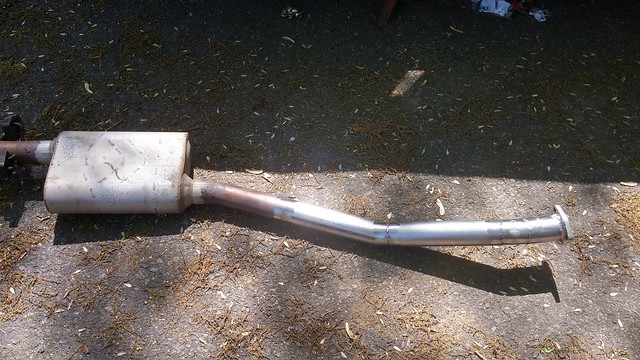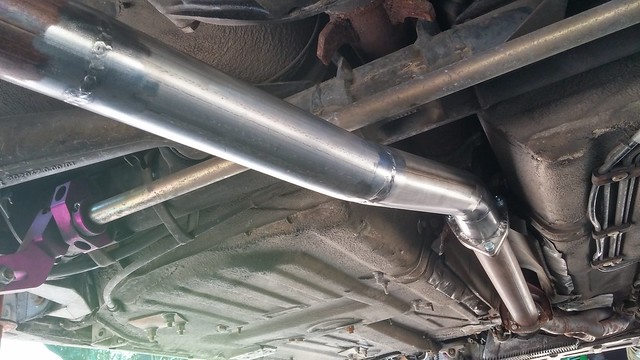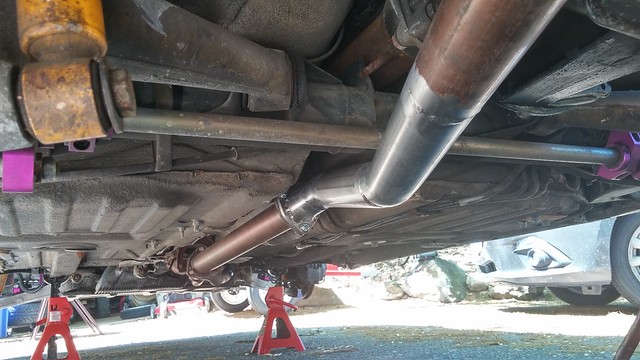Play in transaxle drive flanges?
#16
Instructor
Thread Starter
Join Date: Aug 2015
Location: Washington, DC
Posts: 194
Likes: 0
Received 0 Likes
on
0 Posts
Wow, that's gnarly sounding. I guess I should consider myself fortunate, since mine sounds like something a lot simpler than that hot mess.
#17
Instructor
Thread Starter
Join Date: Aug 2015
Location: Washington, DC
Posts: 194
Likes: 0
Received 0 Likes
on
0 Posts
Van is correct - a little play along the output flange axis is normal, like a couple millimeters. If you indeed have 1/8" to 1/4", that is not normal.
It sounds like your ticking may be more frequent than to be expected from CV joints. I'd still start with the CVs if they have not been services in several years: inspect and repack, rule them out as a possible source, chalk it up to regular maintenance.
Other sources for the ticking noise could be wheel bearings (although ticking is not a usual symptom, they more commonly whine), transmission bearings, brake backing shield contact with rotor, torque tube bearings, muffler vibrating against heat shield. Happy hunting!
It sounds like your ticking may be more frequent than to be expected from CV joints. I'd still start with the CVs if they have not been services in several years: inspect and repack, rule them out as a possible source, chalk it up to regular maintenance.
Other sources for the ticking noise could be wheel bearings (although ticking is not a usual symptom, they more commonly whine), transmission bearings, brake backing shield contact with rotor, torque tube bearings, muffler vibrating against heat shield. Happy hunting!
I like Van's idea about the interface between the torque tube and the transaxle. I have no idea what that looks like, how it's built, what could go wrong, etc.
But I think I'll be removing the transaxle this weekend, and if I don't see a smoking gun, I'll at least have the opportunity for degreasing it and checking out the condition of the shifter linkages.
I have until Sunday to cancel my Watkins Glen HPDE event and still get most of my money back. I'm leaning towards canceling right now just to relieve the self-imposed pressure I'm feeling.

#18
Instructor
Thread Starter
Join Date: Aug 2015
Location: Washington, DC
Posts: 194
Likes: 0
Received 0 Likes
on
0 Posts
I was just reviewing the TRANS-03 procedure on clarks-garage.com and noticed something interesting: Steps 8-11 look like this:
Maybe there's hope?
- Roll the rear wheels until the drive shaft retaining bolts (2) are accessible through the opening in the bottom of the transaxle bellhousing. You'll have to engage the clutch pedal to roll the wheels.
- Mark the position of the clamping sleeve on the drive shaft so that they may be reassembled in the same orientation.
- Using an 8 mm Allen head socket remove the clamping sleeve bolts.
- Slide the clamping sleeve off the drive shaft splines toward the transaxle.
Maybe there's hope?
#19
Rennlist Member
There are access holes for the driveshaft coupler - you can check those bolts easily. The whole thing about the "orientation" is that the coupler is supposed to go on in one direction. You don't be able to access the front bolt if the coupler is on backwards.
If you do take the transaxle out, the coupler slides to the transmission side.
What I'd do is put the car on jack stands, have someone sit in it an step on the clutch, then you can reach in the large access hole and turn the driveshaft by hand and see if you hear anything.
A few more questions for you - do you hear the sound in neutral with the engine running? If so, does it go away when you step on the clutch? Or only when it's in gear? If it's only in gear, does the sound frequency change depending on gear? (e.g. does 3000 RPM in 2nd sound the same as 3000 RPM in 3rd?) Does it happen more under load or under deceleration?
If you do take the transaxle out, the coupler slides to the transmission side.
What I'd do is put the car on jack stands, have someone sit in it an step on the clutch, then you can reach in the large access hole and turn the driveshaft by hand and see if you hear anything.
A few more questions for you - do you hear the sound in neutral with the engine running? If so, does it go away when you step on the clutch? Or only when it's in gear? If it's only in gear, does the sound frequency change depending on gear? (e.g. does 3000 RPM in 2nd sound the same as 3000 RPM in 3rd?) Does it happen more under load or under deceleration?
#20
If you have the time and end up dropping the trans, this is a good chance to fill your stock trans mount with Polyurethane (80a, availiable from McMaster Carr). This really helps the late mount to be more effective under load. The stock late mount lets the trans move quite a bit.
#21
Instructor
Thread Starter
Join Date: Aug 2015
Location: Washington, DC
Posts: 194
Likes: 0
Received 0 Likes
on
0 Posts
A few more questions for you - do you hear the sound in neutral with the engine running? If so, does it go away when you step on the clutch? Or only when it's in gear? If it's only in gear, does the sound frequency change depending on gear? (e.g. does 3000 RPM in 2nd sound the same as 3000 RPM in 3rd?) Does it happen more under load or under deceleration?
I do not hear the sound in neutral with the engine running.
I only hear the sound when it's in gear, and even then, I only hear it when the engine is under load in the forward direction. It does not make a noticeable sound when under deceleration (engine braking). It is absolutely quiet when in gear, in the forward direction, but when there is no load on the engine. There's a definite threshold where I can add just the slightest bit of throttle to create the loud ticking sound. Letting off the slightest bit eliminates the sound altogether.
It does NOT make the sound in reverse, which is possibly an important clue regarding the plausibility of the driveshaft-transaxle interface point. Seems to me I should get the noise no matter which direction the wheels are turning.
#22
Instructor
Thread Starter
Join Date: Aug 2015
Location: Washington, DC
Posts: 194
Likes: 0
Received 0 Likes
on
0 Posts
Tonight I will mount a couple go-pro's underneath the car and drive it around a bit, to try to capture the sound.
I will also try to get some samples at precise RPM's in different gears to compare.
And I will try to record the running gear with the car on stands.
Then, it's off to my Porsche-whisperer friend, Charlie at Intersport.
I will also try to get some samples at precise RPM's in different gears to compare.
And I will try to record the running gear with the car on stands.
Then, it's off to my Porsche-whisperer friend, Charlie at Intersport.
#23
Three Wheelin'
The play is in the flanges on the transaxle is normal...my relatively fresh 951 LSD box has the same amount of play on each flange, as has every other 944 transaxle I've put my hands on (upwards of 8).
Best of luck with the noise.
Ethan
Best of luck with the noise.
Ethan
#24
Rennlist Member
What about in reverse when it's under engine braking (decel)?
#26
Instructor
Thread Starter
Join Date: Aug 2015
Location: Washington, DC
Posts: 194
Likes: 0
Received 0 Likes
on
0 Posts
Ethan, you're really close to me. I'm over in Hillandale (eastern Silver Spring).
PM me if you wouldn't mind taking a listen to this. Thanks for your input!
PM me if you wouldn't mind taking a listen to this. Thanks for your input!
#27
Instructor
Thread Starter
Join Date: Aug 2015
Location: Washington, DC
Posts: 194
Likes: 0
Received 0 Likes
on
0 Posts
I haven't given up on this, but I just needed to take a break from the project. For the past couple days I couldn't even look at the car without feeling like crap about it.
Today I decided I would finish up the tailpipe between the test pipe and the muffler. It is just about done, but I ran out of argon and it will have to wait until I can fill my bottle next week.
This should eliminate any possibility that the exhaust system is causing the noise. Plus it should quiet a bunch of the noises I do know about and make it easier for expert ears to listen in.
Next week I will post some audio.
Today I decided I would finish up the tailpipe between the test pipe and the muffler. It is just about done, but I ran out of argon and it will have to wait until I can fill my bottle next week.
This should eliminate any possibility that the exhaust system is causing the noise. Plus it should quiet a bunch of the noises I do know about and make it easier for expert ears to listen in.
Next week I will post some audio.
#28
Rennlist Member
I have been putzing around with my transaxle for some time now, waiting for the weather to warm up a bit, so I can paint it. When I was removing the c-v shafts, I noticed that the concave centers, both in the output shafts and the on the wheel bearing side were filled with grease. This was done by a PO. I didn't see anything about this in the WSM..Can someone please comment if this is or is not acceptable / or required practice? Thanks.
#29
Instructor
Thread Starter
Join Date: Aug 2015
Location: Washington, DC
Posts: 194
Likes: 0
Received 0 Likes
on
0 Posts
Mine were practically full too.
I read a different (non-Clarks-garage) procedure somewhere that gave guidance on how much grease should be used, and it seemed like you couldn't use that much without filling up the cups.
I wouldn't recommend filling up the boots, but they should have some grease in and between the ribs.
But as far as the cups, I'm guessing it is acceptable, but not required that they be filled.
I used almost an entire 14 oz tub of grease to complete my 4 joints. That meant a lot was mounded on the ends, and if you don't scrape it off and put it into the cups yourself, the edge of the cup will scrape it off for you.
I read a different (non-Clarks-garage) procedure somewhere that gave guidance on how much grease should be used, and it seemed like you couldn't use that much without filling up the cups.
I wouldn't recommend filling up the boots, but they should have some grease in and between the ribs.
But as far as the cups, I'm guessing it is acceptable, but not required that they be filled.
I used almost an entire 14 oz tub of grease to complete my 4 joints. That meant a lot was mounded on the ends, and if you don't scrape it off and put it into the cups yourself, the edge of the cup will scrape it off for you.
#30
Instructor
Thread Starter
Join Date: Aug 2015
Location: Washington, DC
Posts: 194
Likes: 0
Received 0 Likes
on
0 Posts
Thanks everyone.
This weekend I completed the exhaust, and it didn't fix the noise.



So it's nice and isolated and doesn't bang against anything. Now you can hear the damn transaxle noise that much better. :-/
I thought to save time I'd summarize the symptoms and what I have done so far:
Symptoms: The car exhibits a distinctive ticking noise from the rear end in 2nd, 3rd, 4th, and 5th gears.
What I've done so far:
I am working on sourcing a used transaxle in case I need one. Hopefully it's something simpler, though.
* I think I will eventually go with a higher-viscosity gear oil like Red Line MT-95 or Swepco. But the nature of this sound is not a grinding sound... it sounds more mechanical-ticking sound. Like a ratchet. It really doesn't sound like it could simply be corrected with a thicker oil at this point.
Tomorrow I'm taking it in to a shop for a professional diagnosis, and I'll let you know how it goes!
This weekend I completed the exhaust, and it didn't fix the noise.



So it's nice and isolated and doesn't bang against anything. Now you can hear the damn transaxle noise that much better. :-/
I thought to save time I'd summarize the symptoms and what I have done so far:
Symptoms: The car exhibits a distinctive ticking noise from the rear end in 2nd, 3rd, 4th, and 5th gears.
- It happens only on acceleration when in gear, not when coasting or engine braking.
- It's not noticeable in 1st gear or reverse. (Hey Van: it doesn't occur when engine-braking in reverse, either
 )
) - The ticking noise changes frequency with wheel speed, not engine speed.
- It ticks at a much higher frequency than the rear wheel rpm's.
- It began about ten miles from home on my way home from a weekend at Summit Point in March. So it has driven maybe 20 miles like this total.
What I've done so far:
- I have disassembled, inspected, and re-packed all four CV joints with grease - they were fine.
- Both rear bearings are brand new with just the one track weekend on them.
- I built a new exhaust tailpipe and verified that it isn't rubbing or clanging against anything
- I have checked the gearbox oil. It is full and it appears to be in good shape. (It is Red Line MTL which I put in in August 2015)*.
- I have checked the bolts of the mating collar between the torque tube and the transaxle, which appear to be tight.
I am working on sourcing a used transaxle in case I need one. Hopefully it's something simpler, though.
* I think I will eventually go with a higher-viscosity gear oil like Red Line MT-95 or Swepco. But the nature of this sound is not a grinding sound... it sounds more mechanical-ticking sound. Like a ratchet. It really doesn't sound like it could simply be corrected with a thicker oil at this point.
Tomorrow I'm taking it in to a shop for a professional diagnosis, and I'll let you know how it goes!



